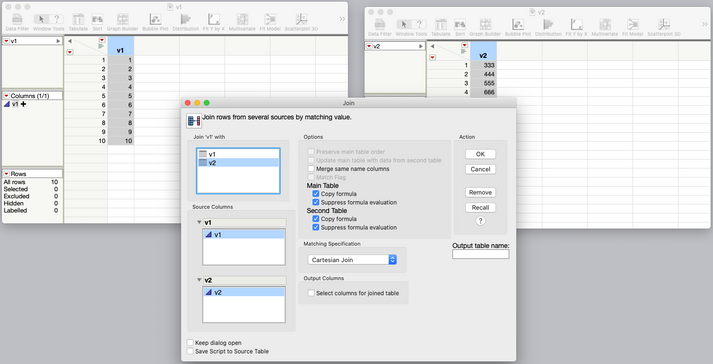- JMP will suspend normal business operations for our Winter Holiday beginning on Wednesday, Dec. 24, 2025, at 5:00 p.m. ET (2:00 p.m. ET for JMP Accounts Receivable).
Regular business hours will resume at 9:00 a.m. EST on Friday, Jan. 2, 2026. - We’re retiring the File Exchange at the end of this year. The JMP Marketplace is now your destination for add-ins and extensions.
- Subscribe to RSS Feed
- Mark Topic as New
- Mark Topic as Read
- Float this Topic for Current User
- Bookmark
- Subscribe
- Mute
- Printer Friendly Page
Discussions
Solve problems, and share tips and tricks with other JMP users.- JMP User Community
- :
- Discussions
- :
- Re: How do I plot mathematical functions with JMP?
- Mark as New
- Bookmark
- Subscribe
- Mute
- Subscribe to RSS Feed
- Get Direct Link
- Report Inappropriate Content
How do I plot mathematical functions with JMP?
I realize that JMP isn't a mathematical function plotter, but suppose I have a function: y=((v1+v2)*sin(v3+arcsine(v1/(v1+v2)))/sin(pi()-v3-arcsine(v1/(v1+v2))-v4/v1)-v1)
... and I'd like to plot it using Graph Builder. Is there a convenient way to do this type of thing with JMP? (preferably without resorting to JSL)
Seems like it would involve building a full-factorial matrix of inputs v1 thru v4, but it's not clear to me how to do that, even with the DOE FFD platform, especially if I'd like some of those variables to have hundreds of values, e.g., v1 to be 0 thru 5000 every 10.
Accepted Solutions
- Mark as New
- Bookmark
- Subscribe
- Mute
- Subscribe to RSS Feed
- Get Direct Link
- Report Inappropriate Content
Re: How do I plot mathematical functions with JMP?
@BHarris wrote:
I understand -- I think I was mostly interested in knowing *how* to build the data table if I knew what levels I wanted for each of the inputs. Basically, is there an easy way to build a full-factorial-matrix data table given a min, increment, and max value for each variable?
Take a look at the Sequence() function (it's the Row functions in the Formula Editor), and also Tables->Join, where you'll find a Cartesian join option.



- Mark as New
- Bookmark
- Subscribe
- Mute
- Subscribe to RSS Feed
- Get Direct Link
- Report Inappropriate Content
Re: How do I plot mathematical functions with JMP?
The Nonlinear Model platform and the simulators work well for this. If I get time, I'll send an example.
- Mark as New
- Bookmark
- Subscribe
- Mute
- Subscribe to RSS Feed
- Get Direct Link
- Report Inappropriate Content
Re: How do I plot mathematical functions with JMP?
Surface Plot can do this too. With NO data tables open, start surface plot from the menu, then set up like this

Show Formulas, replace the default formula with your own formula, pick your axis variables, use the mouse to rotate and adjust the axes. I'm pretty sure your formula generates missing values for some vN values, and the surface is being interrupted by them.
- Mark as New
- Bookmark
- Subscribe
- Mute
- Subscribe to RSS Feed
- Get Direct Link
- Report Inappropriate Content
Re: How do I plot mathematical functions with JMP?
- Mark as New
- Bookmark
- Subscribe
- Mute
- Subscribe to RSS Feed
- Get Direct Link
- Report Inappropriate Content
Re: How do I plot mathematical functions with JMP?
- Mark as New
- Bookmark
- Subscribe
- Mute
- Subscribe to RSS Feed
- Get Direct Link
- Report Inappropriate Content
Re: How do I plot mathematical functions with JMP?
- Mark as New
- Bookmark
- Subscribe
- Mute
- Subscribe to RSS Feed
- Get Direct Link
- Report Inappropriate Content
Re: How do I plot mathematical functions with JMP?
shift key with mouse drag or arrow keys. It saves the rotation angle/speed in the script and will come up already rotating.
- Mark as New
- Bookmark
- Subscribe
- Mute
- Subscribe to RSS Feed
- Get Direct Link
- Report Inappropriate Content
Re: How do I plot mathematical functions with JMP?
ain't that the truth!
- Mark as New
- Bookmark
- Subscribe
- Mute
- Subscribe to RSS Feed
- Get Direct Link
- Report Inappropriate Content
Re: How do I plot mathematical functions with JMP?
I asked about Graph Builder because we need to end up with a family of line plots (X, Y, group X, group Y, overlay) that we can read values from.
But I'm going to share this with the other JMP users at my work, super cool. Thanks!
- Mark as New
- Bookmark
- Subscribe
- Mute
- Subscribe to RSS Feed
- Get Direct Link
- Report Inappropriate Content
Re: How do I plot mathematical functions with JMP?
Recommended Articles
- © 2025 JMP Statistical Discovery LLC. All Rights Reserved.
- Terms of Use
- Privacy Statement
- Contact Us




